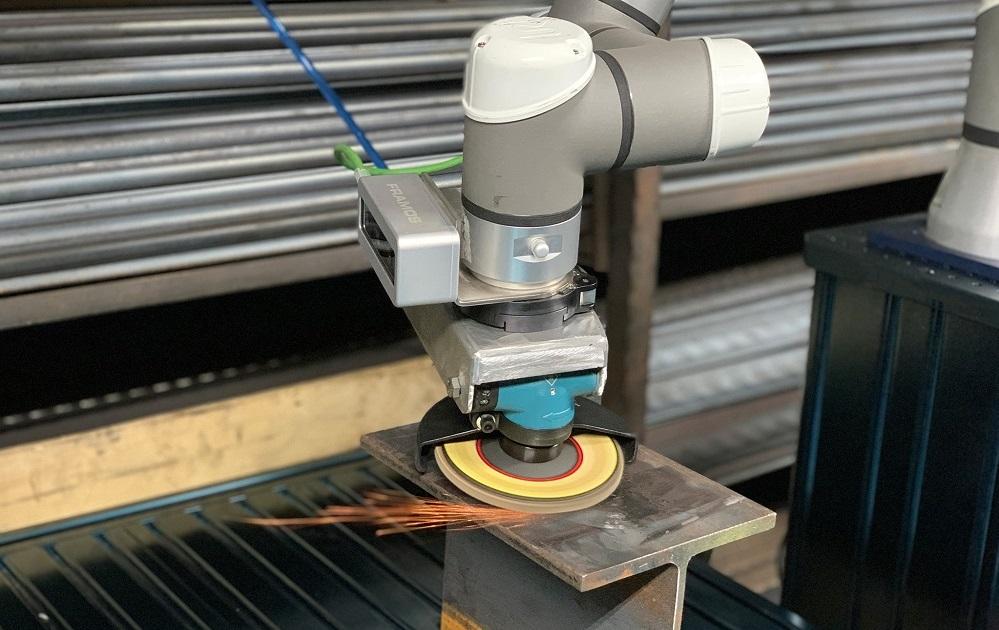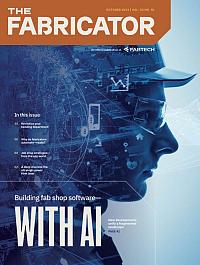Senior Editor
- FMA
- The Fabricator
- FABTECH
- Canadian Metalworking
Categories
- Additive Manufacturing
- Aluminum Welding
- Arc Welding
- Assembly and Joining
- Automation and Robotics
- Bending and Forming
- Consumables
- Cutting and Weld Prep
- Electric Vehicles
- En Español
- Finishing
- Hydroforming
- Laser Cutting
- Laser Welding
- Machining
- Manufacturing Software
- Materials Handling
- Metals/Materials
- Oxyfuel Cutting
- Plasma Cutting
- Power Tools
- Punching and Other Holemaking
- Roll Forming
- Safety
- Sawing
- Shearing
- Shop Management
- Testing and Measuring
- Tube and Pipe Fabrication
- Tube and Pipe Production
- Waterjet Cutting
Industry Directory
Webcasts
Podcasts
FAB 40
Advertise
Subscribe
Account Login
Search
Job shop automation strategies from a former CIA officer
The parallels between robotics in metal fabrication and CIA technical intelligence
- By Tim Heston
- Updated October 20, 2023
- October 19, 2023
- Article
- Shop Management

There's surprising number of parallels between metal fabrication and CIA technical intelligence says David Pietrocola. The former CIA officer now runs an automation business called Cohesive Robotics that serves job shops. Gwengoat / iStock / Getty Images Plus
Different experiences open your eyes to new ways of thinking, and David Pietrocola has spent his career doing just that—including a stint at the CIA. In 2020 he launched Cohesive Robotics, which offers an autonomous robotics platform that today focuses on metal finishing and graining in the job shop.
He’s come full circle. Pietrocola’s earliest work experiences involved wielding a welding gun at his parents’ ornamental and miscellaneous fab business. His parents today run a nationwide distributor of components tailored for the ornamental fab space.
After getting his systems engineering degree at the University of Pennsylvania and working in R&D for defense-related work, he landed a job at the CIA as technical intelligence officer. He’s now back working in custom metal fabrication, an arena seemingly so different from the CIA. Still, Pietrocola sees a plethora of parallels—especially with all the rapid technological innovation happening in even the smallest of operations. He discussed them at FABTECH in Chicago last month.
His message: The modern metal fabrication landscape has become more complex and nuanced. For those who pay attention, gather good data, absorb what’s important, and adapt, the opportunities abound.
Understand the Mission
The CIA’s mission isn’t a secret. It’s right there on its website homepage: We are the nation’s first line of defense.
“From the agency’s perspective, the mission drives everything they do,” Pietrocola said, “especially when it comes to informing policymakers and, ultimately, the president of the United States. From the fabricator’s perspective, that mission should be central to everything the business does.”
At a custom fabricator, the mission usually has to do with helping people have an impact. They need to know that what they’re doing matters. Someone operating a plasma cutting table might be cutting parts that end up on wind turbines, water filtration, or some other project that buttresses (often literally) modern society. Even something as seemingly insignificant as a handrail can prevent a fall and keep loved ones safe. A fabricator’s work makes all that happen, and developing a mission statement that communicates that fact can anchor an enterprise amid disruptive seas.
Prepare for Disruption
“At the agency, we always had to be looking forward,” Pietrocola said. “How do we protect our people and assets? We always needed to identify the potential for disruption.”
Successful fab shop leaders look out for disruption too. Looking out for disruption could involve going to shows like FABTECH and other industry events (both domestically and internationally), reading industry publications, networking, and vetting any new discovery. “Don’t believe all the hype,” Pietrocola said. “When you learn of something new, understand where that technology or trend is in its maturity. What’s the adoption curve, and how will it really fit in your business?”
Also, because disruption is now a given, any technology that prevents adapting to that disruption down the road should throw up a red flag. “The interoperability of technology will continue to become more important. Avoid vendor lock-in, especially when you evaluate new technologies.”

David Pietrocola, founder of Cohesive Robotics, has had a varied career that included a stint in the CIA. Cohesive Robotics
Good Data Builds Trust
Shop managers often don’t believe the hype because, in essence, they don’t trust the fact a new technology or process could really help them. At the same time, though, failing to move forward also has its consequences.
Here is where building trust comes into play. Of course, there’s no place for blind trust. As Pietrocola described, trust upon which smart decisions are made requires good information, both from people and technology.
Information gleaned from meetings, shop floor huddles, even someone clocking in and out of a job on an ERP system—all that would be considered “data gathered by people.” Direct monitoring, with sensors and software that tap into a machine or system (that is, no human intervention in between), would be considered “data gathered by technology.”
Operations really need both. After all, people can miscommunicate or misunderstand, and machine sensors can go bad. Moreover, each kind of data-gathering can give an incomplete picture. Say a sensor detects a press brake ram is idle when it shouldn’t be. That’s fine, but why? Talking with operators during a huddle can fill in the gaps and identify previously hidden problems.
Of course, getting the data just sets the foundation. Pietrocola referred to the DIKW pyramid: Data is at the base, on top of which sits Information, Knowledge, and (at the very top) Wisdom.
“All this makes data useful for decision-making,” Pietrocola said, adding that if the data isn’t solid, the entire pyramid could teeter.
Pietrocola continued with a CIA analogy. “When it comes to intelligence, we have data that comes in from a technical source or a human source. With the human source, how do I trust the information they’re reporting?
“When it comes to intel analysis, we often didn’t have the complete picture,” Pietrocola continued. “That was a challenge. So, we asked, ‘What can we infer, based on history and other contacts and sources?’ A big piece of this was understanding how true a data source was. Is it a source I can trust?”
Train and Cross-Train
“The agency did a wonderful job training and cross-training,” Pietrocola said, “building in knowledge gained from past successes and mistakes.” Good training and cross-training at the CIA, he said, allowed the organization to push more decision-making to the front lines—a necessity, since agents in the field often can’t communicate with their superiors. They have the authority to act—not on a whim but based on well-documented and proven processes.
Back in the job shop, if people aren’t trained around well-documented and -communicated processes, they won’t know if what they’re doing is right or wrong. It’s also tough to improve without having at least a somewhat consistent starting point to use as a benchmark.

Cohesive Robotics focuses on finishing operations for the metal fabrication job shop, a manufacturing step that remains largely manual across the industry. Cohesive Robotics
Even worse, lack of consistent processes in the shop can make data-gathering a quixotic affair. The data’s so varied that it becomes useless. Yes, productivity levels likely will change some based on worker experience. But good training should at least minimize the variation.
Back to the Mission
Good training and process documentation help uncover inherent inefficiencies previously ignored or swept under the rug. They also help uncover those manufacturing steps that lack good data, like manual processes that lean greatly on worker experience.
This last point is what drew Pietrocola to finding ways to automate the finishing and graining process in high-product-mix scenarios. “Fab shops have become so automated in some areas, like cutting and welding, but when you get to finishing, it’s still a black box, and they don’t know the numbers like they do in other areas of the shop.”
At this point, all the pillars of good shop management (and an effective intelligence agency) start blending together. A shop with a well-defined and engaging mission hires well, onboarding people who connect with that mission and, hence, engage in the work they’re assigned.
Once they’re well trained in various areas of job shop operation and prove their mettle through experience, they’re given authority and resources to act and adapt. They also don’t hesitate to question the status quo, look at the data, work their way up the DIKW pyramid, and move forward with the mission.
“In the agency world, the mission above all else drives everyone,” Pietrocola said. “You really felt it when you went into work. It’s not an apples-to-apples comparison here, of course, but any shop, or any organization, for that matter, can take a page from that, especially as fabricators hire younger workers. The mission gives everyone purpose.”
About the Author

Tim Heston
2135 Point Blvd
Elgin, IL 60123
815-381-1314
Tim Heston, The Fabricator's senior editor, has covered the metal fabrication industry since 1998, starting his career at the American Welding Society's Welding Journal. Since then he has covered the full range of metal fabrication processes, from stamping, bending, and cutting to grinding and polishing. He joined The Fabricator's staff in October 2007.
Related Companies
subscribe now

The Fabricator is North America's leading magazine for the metal forming and fabricating industry. The magazine delivers the news, technical articles, and case histories that enable fabricators to do their jobs more efficiently. The Fabricator has served the industry since 1970.
start your free subscription- Stay connected from anywhere

Easily access valuable industry resources now with full access to the digital edition of The Fabricator.

Easily access valuable industry resources now with full access to the digital edition of The Welder.

Easily access valuable industry resources now with full access to the digital edition of The Tube and Pipe Journal.
- Podcasting
- Podcast:
- The Fabricator Podcast
- Published:
- 04/16/2024
- Running Time:
- 63:29
In this episode of The Fabricator Podcast, Caleb Chamberlain, co-founder and CEO of OSH Cut, discusses his company’s...
- Trending Articles
Tips for creating sheet metal tubes with perforations

Are two heads better than one in fiber laser cutting?

Supporting the metal fabricating industry through FMA

JM Steel triples capacity for solar energy projects at Pennsylvania facility

Omco Solar opens second Alabama manufacturing facility

- Industry Events
16th Annual Safety Conference
- April 30 - May 1, 2024
- Elgin,
Pipe and Tube Conference
- May 21 - 22, 2024
- Omaha, NE
World-Class Roll Forming Workshop
- June 5 - 6, 2024
- Louisville, KY
Advanced Laser Application Workshop
- June 25 - 27, 2024
- Novi, MI


























